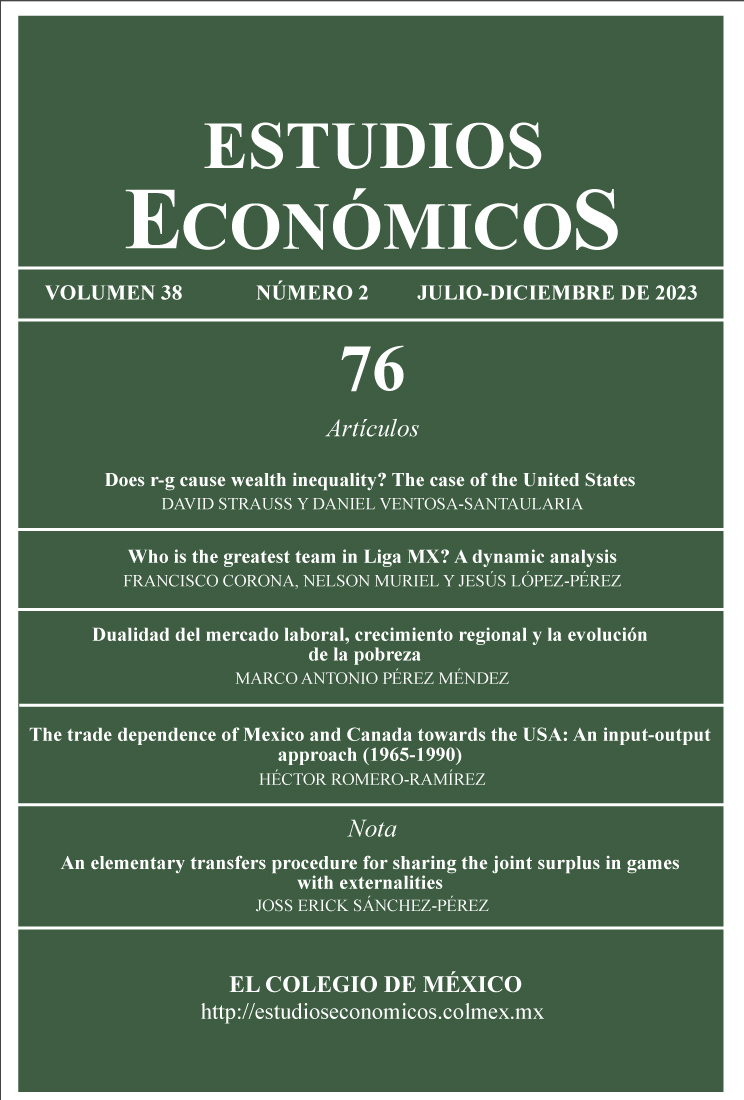Publicado 2023-07-20
Palabras clave
- variables financieras,
- fútbol,
- grandeza,
- popularidad,
- análisis de componentes principales
Cómo citar
Resumen
En este trabajo presentamos un procedimiento estadístico para responder a un cuestionamiento frecuentemente realizado por el periodismo deportivo mexicano: ¿cuál es el equipo más grande de la Liga MX? Se realizan Análisis de Componentes Principales a diversos conjuntos de datos durante el periodo 2011-2019, que incluyen variables relacionadas con éxitos deportivos - tanto nacionales como internacionales - y otras como la popularidad y el valor de mercado de los equipos. Los resultados permiten analizar el concepto de “grandeza” en el tiempo, lo anterior a través de la variable latente estimada. Concluimos que el equipo más grande dentro del periodo analizado es el Club América, seguido del C.D. Guadalajara y del C.F. Cruz Azul. Adicionalmente, en la actualidad, el Club Tigres de la Universidad Autónoma de Nuevo León y el C.F. Monterrey desplazan a equipos como el Deportivo Toluca F.C. y el Club Universidad Nacional.
Descargas
Citas
- Ahn, S. and A. Horenstein. 2013. Eigenvalue ratio test for the number of factors, Econometrica, 81(3): 1203-1227. DOI: https://doi.org/10.3982/ECTA8968
- Bai, J. and S. Ng. 2004. A PANIC attack on unit roots and cointegration, Econometrica, 72(4): 1127-1177. DOI: https://doi.org/10.1111/j.1468-0262.2004.00528.x
- Bai, J. and S. Ng. 2013. Principal components estimation and identification of static factors, Journal of Econometrics, 176(1): 18-29. DOI: https://doi.org/10.1016/j.jeconom.2013.03.007
- Baker, R. and I. McHale. 2015. Time varying ratings in association football: The all-time greatest team is..., Journal of the Royal Statistical Society: Series A (Statistics in Society), 178(2): 481-492. DOI: https://doi.org/10.1111/rssa.12060
- Corona, F., N. Muriel, and G. González-Farías. 2021. Dynamic factor structure of team performances in Liga MX, Journal of Applied Statistics, 49(7): 1900-1912. DOI: https://doi.org/10.1080/02664763.2021.1881946
- Corona, F., J. Tena, and M. Wiper. 2017. On the importance of the probabilistic model in identifying the most decisive games in a tournament, Journal of Quantitative Analysis in Sports, 13: 11-23. DOI: https://doi.org/10.1515/jqas-2016-0013
- ESPN. 2019. Los cuatro 'grandes' de Liga MX fracasan en inferiores, https://www.espn.com.mx/futbol/mexico/nota/_/id/5296826/los-cuatro-grandes-de-liga-mx-fracasan-en-inferiores.
- Faitelson. 2017. "Animal" de liguilla, https://www.espn.com.mx/blogs/index?nombre=david_faitelson&entryID=3729412
- Georgievski, B. and L. Labadze. 2020. Success factors and revealed comparative advantage in the NBA, Journal of Physical Education and Sport, 20(6): 3420-3427.
- Georgievski, B., L. Labadze, and M.E. Aboelsoud. 2019. Comparative advantage as a success factor in football clubs: Evidence from the English Premier League (EPL), Journal of Human Sport and Exercise, 14(2): 292-314. DOI: https://doi.org/10.14198/jhse.2019.142.04
- Glickman, M. and H. Stern. 1998. A state-space model for national football league scores, Journal of the American Statistical Association, 43(441): 25-35. DOI: https://doi.org/10.1080/01621459.1998.10474084
- Jolliffe, I.M. 2010. Principal Component Analysis, New York, Springer. DOI: https://doi.org/10.1007/978-3-642-04898-2_455
- Maher, M.J. 1982. Modelling association football scores, Statistica Neerlandica, 36: 109-118. DOI: https://doi.org/10.1111/j.1467-9574.1982.tb00782.x
- Mikolajec, K., A. Maszczyk, and T. Zajkac. 2013. Game indicators determining sports performance in the NBA, Journal of Human Kinetics, 37(1): 145-151. DOI: https://doi.org/10.2478/hukin-2013-0035
- Onatski, A. 2010. Determining the number of factors from empirical distribution of eigenvalues, The Review of Economics and Statistics, 92(4): 1004-1016. DOI: https://doi.org/10.1162/REST_a_00043
- Stefani, R. and R. Pollard. 2007. Football rating systems for top-level competition: A critical survey, Journal of Quantitative Analysis in Sports, 3(3): 1-17. DOI: https://doi.org/10.2202/1559-0410.1071
- Stock, J.H. and M.W. Watson. 2011. Dynamic factor models, in M.P. Clements and D.F. Hendry (eds.), Oxford Handbook of Economic Forecasting, Oxford, Oxford University Press. DOI: https://doi.org/10.1093/oxfordhb/9780195398649.013.0003
- Velázquez-Guadarrama, C. and J.M. Hernández-Velázquez. 2022. Cambio de director técnico en el fútbol mexicano. Evidencia de 2009 a 2018, Estudios Económicos, 37(1): 149-170. DOI: https://doi.org/10.24201/ee.v37i1.428

